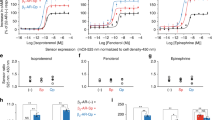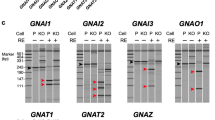Abstract
AGONIST-BOUND receptors activate heterotrimeric (αβγ) G proteins by catalysing replacement by GTP of GDP bound to the a subunit, resulting in dissociation of α-GTP from the βγ subunits. In most cases, α-GTP carries the signal to effectors, as in hormonal stimulation1–4 and inhibition5,6of adenylyl cyclase by αs and αi, respectively. By contrast, genetic evidence in yeast7 and studies in mammalian cells8–10 suggest that βγ subunits of G proteins may also regulate effector pathways. Indeed, of the four recombinant mammalian adenylyl cyclases available for study11–14, two, adenylyl cyclases II and IV, are stimulated by βγ. This effect of βγ requires costimulation by αs-GTP14,15. This conditional pattern of effector responsiveness led to the prediction15 that receptors coupled to many G proteins will mediate elevation of cellular cyclic AMP, provided that Gs is also active. We now confirm this prediction. Coexpression of mutationally active αs with adenylyl cyclase II converted agonists that act through 'inhibitory' receptors (coupled to Gi) into stimulators of cAMP synthesis. Experiments using pertussis toxin and a putative scavenger ofβγ , the α subunit of transducin, suggest that βγ subunits of the Gi proteins mediated this stimulation. These findings assign a new signalling function to βγ subunits of Gi proteins, the conditional stimulation of cAMP synthesis by adenylyl cyclase II.
This is a preview of subscription content, access via your institution
Access options
Subscribe to this journal
Receive 51 print issues and online access
$199.00 per year
only $3.90 per issue
Buy this article
- Purchase on Springer Link
- Instant access to full article PDF
Prices may be subject to local taxes which are calculated during checkout
Similar content being viewed by others
References
Birnbaumer, L. A. Rev. Pharmac. Tox. 30, 675–705 (1990).
Kaziro, Y., Itoh, H., Kozasa, T., Nakafuku, M. & Satoh, T. A. Rev. Biochem. 60, 349–400 (1991).
Bourne, H. R., Sanders, D. A. & McCormick, F. Nature 348, 125–132 (1990).
Freissmuth, M., Casey, P. J. & Gilman, A. G. FASEB J. 3, 2125–2131 (1989).
Wong, Y. H. et al. Nature 351, 63–65 (1991).
Wong, Y. H., Conklin, B. R. & Bourne, H. R. Science 255, 339–342 (1992).
Whiteway, M., Hougan, L., Dignard, D., MacKay, V. & Thomas, D. Y. Cold Spring Harb. Symp. quant. Biol. 53, 585–590 (1988).
Logothetis, D. E., Kurachi, Y., Galper, J., Neer, E. J. & Clapham, D. E. Nature 325, 321–326 (1987).
Jelsema, C. L. & Axelrod, J. Proc. natn. Acad. Sci. U.S.A. 84, 3623–3627 (1987).
Kim, D. et al. Nature 337, 557–560 (1989).
Krupinski, J. et al. Science 244, 1558–1564 (1989).
Bakalyar, H. A. & Reed, R. R. Science 250, 1403–1406 (1990).
Feinstein, P. G. et al. Proc. natn. Acad. Sci. U.S.A. 88, 10173–10177 (1991).
Gao, B. & Gilman, A. G. Proc. natn. Acad. Sci. U.S.A. 88, 10178–10182 (1991).
Tang, W.-J. & Gilman, A. G. Science 254, 1500–1503 (1991).
Cotecchia, S. et al. J. biol. Chem. 265, 63–69 (1990).
Fraser, C. M., Arakawa, S., McCombie, W. R. & Venter, J. C. J. biol. Chem. 264, 11754–11761 (1989).
Grandy, D. K. et al. Proc. natn. Acad. Sci. U.S.A. 86, 9762–9766 (1989).
Masters, S. B. et al. J. biol. Chem. 264, 15467–15474 (1989).
Medynski, D. C. et al. Proc. natn Acad. Sci U.S.A. 82, 4311–4315 (1985).
Sattin, A., Rall, T. W. & Zanella, J. J. Pharmac. exp. Ther. 192, 22–32 (1975).
Daly, J. W. et al. J. Pharmac. exp. Ther. 212, 383–389 (1980).
Karbon, E. W. & Enna, S. J. Molec. Pharmac. 27, 53–59 (1985).
Hill, D. R. Br. J. Pharmac. 84, 249–257 (1985).
Tang, W.-J., Krupinski, J. & Gilman, A. G. J. biol. Chem. 266, 8595–8603 (1991).
McFarland, K. C. et al. Science 245, 494–499 (1989).
Guyer, C. A., et al. J. biol. Chem. 265, 17307–17317 (1990).
Salomon, Y., Londos, C. & Rodbell, M. Ana Biochem. 58, 541–548 (1974).
Mahan, L. C. et al. Molec. Pharmac. 40, 1–7 (1991).
Author information
Authors and Affiliations
Rights and permissions
About this article
Cite this article
Federman, A., Conklin, B., Schrader, K. et al. Hormonal stimulation of adenylyl cyclase through Gi-protein βγ subunits. Nature 356, 159–161 (1992). https://doi.org/10.1038/356159a0
Received:
Accepted:
Issue Date:
DOI: https://doi.org/10.1038/356159a0
Comments
By submitting a comment you agree to abide by our Terms and Community Guidelines. If you find something abusive or that does not comply with our terms or guidelines please flag it as inappropriate.



